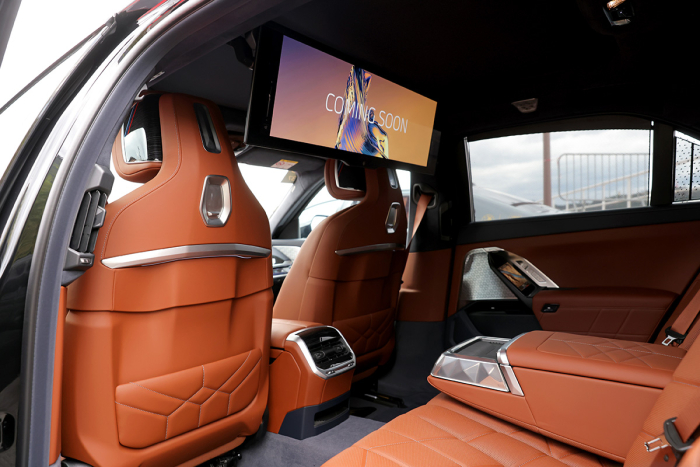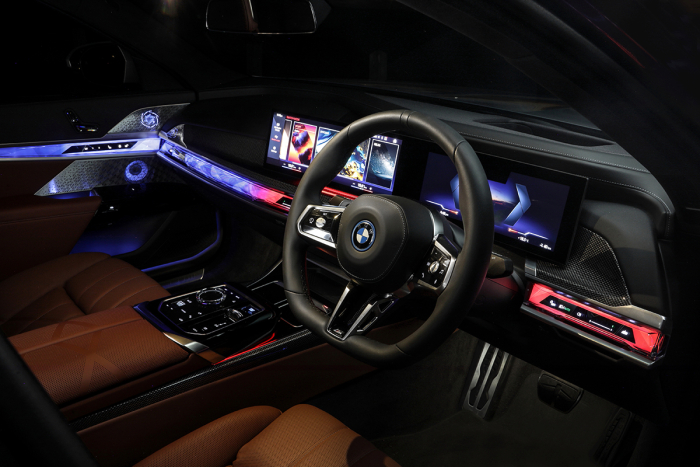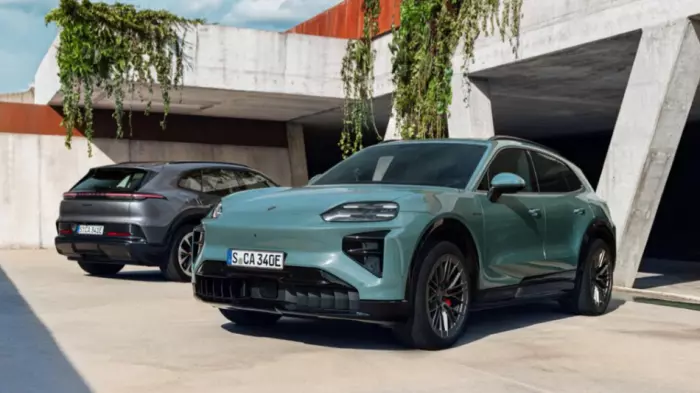The family and I agree. We’re going to put off the house renovation and just buy a BMW i7. It will be marginally cheaper and, regardless, a car with four massage seats beats a second bathroom in our minds.
Also, the doors open automatically on the Beamer, and there’s no way we could do that in the house.
This is Bavaria-based BMW’s top-of-the-line limousine-style electric vehicle. It weighs 2700kg and I’m pretty sure most owners will nickname it “The Beast”.
It does 0-100km/h in 4.7 seconds, despite having to propel all that weight forward. A stonking 745Nm of torque and 400kW of power provide the Teutonic muscle.
A 106.5kW battery gives a stated range of 625km and in my week of driving the i7 around Auckland and further afield, this felt close to accurate.
The interior is luxe and refined, with lots of leather and big screens.
 The drop-down back-seat display will be great for meetings on the go, or the latest Marvel movie. (Image: Supplied)
The drop-down back-seat display will be great for meetings on the go, or the latest Marvel movie. (Image: Supplied)Later this year, you'll also be able to order the i7 with a 31.3-inch panoramic 8K touchscreen display that sits on the ceiling but drops into place in front of the rear passengers at the touch of a button.
Driving the i7 is not an experience for the faint-hearted. It is a big car. Real big. It approaches a little like Sam Whitelock barrelling down a rugby field. Still, hitting the accelerator too hard will push the car forward in a way reminiscent of a rocket launch.
The i7 monitors the road in front and will gently apply brakes even if not in adaptive-cruise-control mode. Normally, I’d hate this, but it is such a sophisticated implementation that I ended up being happy to give up a little autonomy to the car in exchange for a few extra kilometres of range via regenerative braking.
Just don’t think about how expensive the i7 is as you are weaving through city traffic. At $281,000, you could (nearly) renovate a house in Auckland instead of buying it, but this car would be far more fun.
Two-tone paintwork costs $17,500 extra, but many of the other extras (wheel choices, etc) are included in the price.
The 35-speaker Bowers & Wilkins surround-sound system is massively and pleasantly over-engineered. It is cinema-level audio quality, including subwoofers in the seats so the bass runs directly into your backside.
The touchscreen system is massive but also complicated in a BMW way. There were a few things I couldn’t find, such as how to keep the car in standard mode without a video of the road ahead in the steering wheel dashboard. I ended up just swapping to a different mode every time I got in. I’m sure if I owned the car, I’d invest the time to work it all out, of course.
Likewise, a screen to control the doors popped up at one stage, but I couldn’t find it again.

Rear-seat passengers can control features such as the air-con, stereo and blockout blinds via an iPhone-style screen. (Image: Supplied)
One great feature: jump in the car and then put your foot on the brake to start up and the driver’s door will magically close. In this busy modern world, it’s just one less thing to worry about, I guess.
The voice control gets better and better with BMW. This is coupled with gesture control for things like changing the radio station, skipping to the next song or turning the volume down when Ed Sheeran comes on again. Combined, voice and gesture controls make the screens a little redundant.
The i7 xDrive 60 (its full name) is a seriously luxurious vehicle. Its price is well up into Bentley territory, and given the innovation happening over at BMW-owned Rolls-Royce, I’d be a little worried if I was Bentley. This is a pincer movement from above and below.
The i7's more direct competition is the Mercedes EQS 53, which clocks in at $311,000. I think that as a limousine, though, the BMW has the edge – it has more tech in it than any car I’ve seen.
Last year, I got a bit of time in the Rolls-Royce Black Badge Ghost, which costs $500,000 more than the i7. I reckon the i7 is all the car the average oligarch or captain of industry would ever need – at least until the electric Rolls-Royce Spectre comes out later this year.
 The interior is rich with screens.
The interior is rich with screens.















